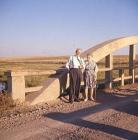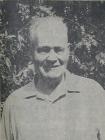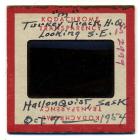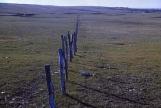1
Through the Eyes of Everett Baker January 28, 1893 to April 19, 198110 September 1970
Shaunavon, Saskatchewan, Canada
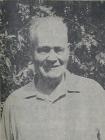
2
Through The Eyes of Everett BakerJanuary 28, 1893 to April 19, 1981
10 September 1970
Shaunavon, Saskatchewan, Canada
3
Through the Eyes of Everett Baker January 28, 1893 to April 19, 198110 September 1970
Shaunavon, Saskatchewan, Canada

4
"Captured most people there" (excerpt from Everett Baker's diary, July 16, 1958,) best describes Everett Baker's passion for Saskatchewan people, places, and events. Through the use of photography, this amateur photographer captured the lives and events of every day individuals living in Saskatchewan from the late 1930's to the early 1970's. Baker's interests included a variety of subjects and in particular, the social and natural history of Saskatchewan. He worked diligently on a number of projects to encourage the preservation of Saskatchewan's history. By capturing people and events on film, presenting early slide shows to groups throughout the province, along with a gift for story telling, Mr. Baker created an awareness in people young and old, on the importance of this history. In his latter years, Mr. Baker donated over 10,000 colour slides to the Co-operative College of Canada which were eventually donated to the Saskatchewan History and Folklore Society. Through this donation, the slides continue to be utilized for research purposes but also the tradition of slide shows continues! Presentations by the Society continue to draw audiences and inspire viewers. These slides along with countless others found in many private and public collections, serve as a lasting legacy for the people of Saskatchewan, something which Mr. Baker had intended.6
Everett Baker was born in Blue Earth County, Minnesota on January 28, 1893. He completed a Bachelor of Science Degree in 1916, and in 1917 he came to Saskatchewan selling "Peoples' Home Library", a book filled with information including several home remedies, recipes, medical and veterinary information as well as other practical material. Baker suffered from asthma and believed that the drier Saskatchewan climate would be easier for his health. On June 25, 1918, he married Ruth Hellebo and the couple moved to South West Saskatchewan to a farm near Aneroid. Ruth continued to teach school following her marriage and Everett quickly became involved in several farm organizations. He served as the Secretary for the local Grain Growers' Association, as delegate to the Associations' meetings and an organizer for the southwest region of the Saskatchewan Wheat Pool. Following a few years of farming, and many events that occurred during that time including the birth of two children, Everett and Ruth sold the farm in 1924 and moved into the community of Aneroid where he organized and became the first manager of the Aneroid Co-operative, a position he held until 1931. In 1931, the Aneroid Co-op failed as did many businesses during the 1930's and Everett was forced to seek alternate employment. In 1937, he joined the field staff of the Saskatchewan Wheat Pool, serving for 8.5 years in the North Battleford area, 2.5 years in Regina and in 1948, he moved to Shaunavon where he remained employed as a fieldman until his retirement in July of 1958. 1937 also marked the year of the purchase of his first camera, an event that would lead to his interest in photography not only as a hobby but as a mechanism for him to raise awareness of the heritage of the province.8
Everett could not be considered 'retired' in 1958 but rather, this marked the time for even greater pursuits of his interests. From approximately 1950 to 1981, Baker contributed several articles to a variety of publications, served as the first President of the Saskatchewan History & Folklore Society, worked as a field staff person for the Glenbow Foundation (Calgary, Alberta, Canada), organized the marking of the North West Mounted Police Trail from Wood Mountain to Fort Walsh in Southwest Saskatchewan, served as Director of the Shaunavon Credit Union, organized tours of the province and organized the creation of Pine Cree Park, now a regional park located near Shaunavon, Saskatchewan, Canada to name just a few of his accomplishments! During all of this time, Everett was always seen with a camera in hand, capturing the lives and events of the people and places that he visited. In the late 1970's, Everett's eyesight began to fail and he relied on others to assist him in the completion of his publications and in driving to various locations. In 1981, Everett donated over 10,000 slides to the Co-operative College of Canada. The collection was in turn donated to the Saskatchewan History & Folklore Society. Everett's photography collection not only extended to the donation of the slides to organizations, but Baker was also known for his willingness to give copies of his photos to the individuals found in his images. Numerous families throughout Southwest Saskatchewan in particular, received copies of the photos as a memento of the visit with the Bakers. Today those images remain as special reminders of the mark left by Mr. Baker on the lives of its residents.Everett died in Shaunavon on April 19, 1981 followed by his wife Ruth on October 1, 1982. Interestingly, Everett never became a Canadian citizen as he felt strongly that it was wrong to swear allegiance to the Monarchy. He believed firmly in "government of the people by the people for the people".
10
Everett Baker became involved with a group of Czechoslovakian - German immigrants during his stay in North Battleford in the 1930's. These Sudeten Settlers, often came from professional lives in their homeland prior to their settlement on poor farmland in the North Battleford area. Baker worked towards helping their situation by writing letters, collecting boxes of used clothing and managed to supply them with a subscription to the Western Producer, a magazine owned by the Co-operative Wheat Producers at that time. The visit to the Sudeten settlers was described by Mr. Baker as "one of the most heart - warming experiences of our lives we went to welcome them to such co-operative activities as we have here in their new homeland. We find them co-operating already in building homes, in providing their meat supply, and in other ways. To see peoples' faces light up at proffered friendship, to feel their gratefulness for any little assistance, brings us to the real basis for co-operation - from each according to his ability to each according to his need." (The Western Producer, Saskatoon, Saskatchewan, Canada, July 20, 1939).In 1939, Everett purchased a Leica camera from one of the refugees, Gaby Haas, for $100.
And so his passion for photography began!
Gaby Haas later wrote: "I certainly didn't like to part with my Leica, but now I am glad you bought it. I see you appreciate the machine in a way I never did, and it is a great help with your work. I imagine you take many nice and interesting snaps and I expect to see them sometime."
Gaby Haas to Everett Baker, Letter, 7 February 1943, Saskatchewan Archives, Regina, Saskatchewan, Canada and re-printed in the book "Everett Baker: Picturing a Utopian Reality" by Heather Smith, Moose Jaw Museum & Art Gallery.
